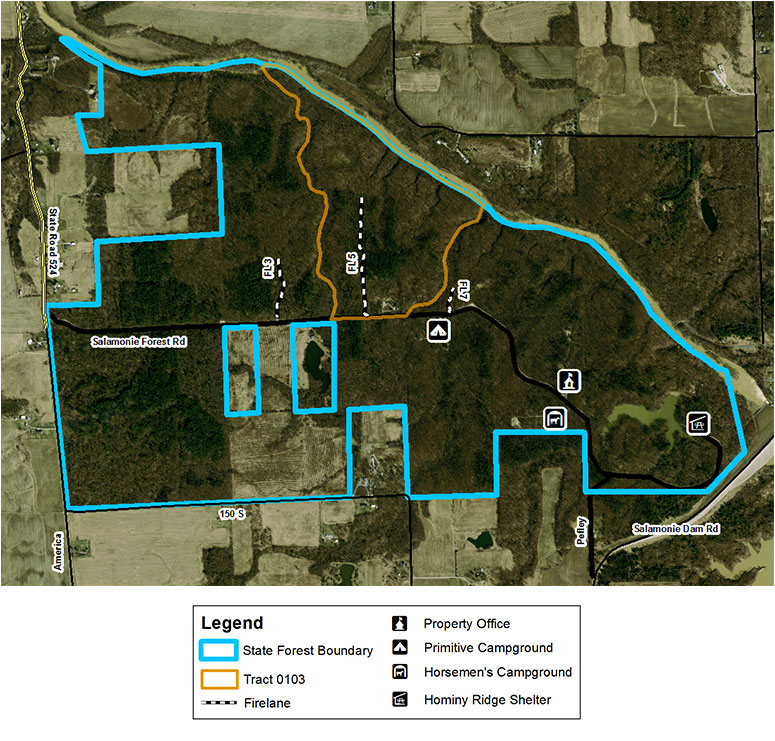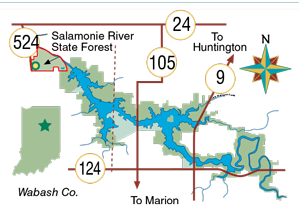Timber Harvest at Salamonie River State Forest

Aerial view of Salamonie River State Forest from 2013.
Forestry personnel have marked trees for a timber harvest on Salamonie River State Forest in Compartment 1, Tract 3 , with plans of selling it in 2019. Total acreage of this tract is 121 acres, but not all of it will be marked for harvest. The majority of the planned harvest consists of thinning and single-tree selection. No clear-cuts are planned for this timber harvest.
During the 1800s to early 1900s, portions of this tract were cleared for agricultural use. These areas were planted with pine by the CCC (Civilian Conservation Corps, Camp 589) in the late 1930s. Many of the pines are now in decline or have already died, and hardwoods have begun to move into the area. The tract also contains older mixed hardwoods, mainly located along the Salamonie River and in drainages.
Salamonie River State Forest is located just northwest of Salamonie Lake between Wabash and Huntington cities in northeast central Indiana. Today, the property covers roughly 956 total acres. Of the 956 acres:
- roughly 87.5% is wooded (this percentage includes the Primitive Campground and the Hominy Ridge Picnic Area),
- 2.5% is open field/grassland (this includes the Horsemen’s Campground and the property office, maintenance building, and residence),
- 8.85% is brush areas,
- 1.15% is covered by Hominy Lake.
Goal of the harvest
The goal of the improvement harvest at Salamonie River State Forest is to remove some of the dying, over-mature, poorly formed, suppressed and damaged trees in order to release the better quality, healthy trees in the area. This will improve spacing and resource availability to the remaining trees, allowing them to grow. This work is accomplished by individually selecting each tree that will be be harvested.
The Division of Forestry is charged to manage, protect and conserve the timber, water, wildlife, soil and related forest resources for the use and enjoyment of present and future generations, and to demonstrate proper forest management to Indiana landowners.
Forest practice and research shows that periodic timber removal assists in maintaining the overall health of the forest, including managing for endangered species management, soil and water protection, sustainable timber, production and recreational activities. Learn more about timber harvesting in Indiana State Forests.
Frequently asked questions
- Will visitors to the property be affected?
The harvest will be planned to limit restrictions to hikers and horse riders, with the anticipated harvest window during the recreation off-season. Safety will be paramount during this harvest.
- Will this reduce recreation opportunities in Northeast Indiana?
No, the Division of Forestry’s forest management plans include recreation assessments as well as wildlife, cultural resources, soil, hydrology, topography, geology and landscape components. Under Forestry’s management, the forest continues to provide numerous recreational opportunities (hiking, fishing, hunting, horseback riding and camping) and diverse natural communities, all while being managed as a productive and healthy working forest.
In addition to the recreational opportunities provided at Salamonie River State Forest, DNR has numerous state parks and reservoirs located in Northern Indiana managed with a primary focus to offer recreational opportunities.
- Was Salamonie River State Forest ever a State Park?
No. One misconception is that the Division of State Parks used to manage Salamonie River State Forest. In fact, State Parks never managed the forest resources that are Salamonie River State Forest—only the recreational resources (i.e., trails, campground at Salamonie River State Forest, etc.) were managed by the Division of State Parks. The Division of Forestry continued to manage the forest resources throughout that period, which started with the "merger” of the Division of State Parks and what was then the Division of Reservoir Management in 1996. Before that, the Division of Forestry managed both the recreation resources and the forest resources at Salamonie River State Forest. Although the Division of State Parks dropped the “and Reservoirs” portion of its name a few years ago, it continues to manage the recreation at U.S. Army Corps of Engineers reservoirs, one of which is Salamonie Lake, which includes property bordering Salamonie River State Forest.
- Should Salamonie River State Forest become a State Park?
Salamonie River State Forest has been a part of the Division of Forestry since 1933. The property already offers camping, hiking, horseback riding, collection of mushrooms, etc., as well as hunting opportunities. Through forest management, the Division of Forestry is providing unique forest habitat for numerous wildlife species, including habitat for some federal and state threatened species that cannot be provided by property managed by the Division of State Parks. See the Hardwood Ecosystem Experiment website for more information on the value of forest management to Indiana’s native wildlife.
- What it the process for the petition to change Salamonie River State Forest to a State Park?
- Is DNR Forestry financed or influenced by the private hardwood industry?
The Division of Forestry timber sales are open to the public, and all records are public. The Division of Forestry never exchanges money with the hardwood industry and does not accept any gifts, per state ethics laws. DNR Forestry— staffed by professional foresters and other scientists with a combined 500-plus years of field experience—is evaluated annually by the Forest Stewardship Council® and the Sustainable Forestry Initiative® program. For 12 consecutive years, these two independent audits have certified DNR Forestry meets nationally and internationally recognized standards for sustainable forestry management.
- Is it true that logging in State Forests has increased 400%?
While it’s true that the harvested volume has increased, it’s also true that the volume available in State Forests has increased as trees have naturally aged and grown larger over time. It is important to understand that the Division of Forestry is harvesting the same proportion of volume today on State Forests as it did 20-25 years ago—what’s different is that the overall forest is older and has more large trees in it. Also, as Indiana’s State Forests have matured over the years, natural mortality has increased significantly. Much of the harvesting done in recent years has focused on salvaging stands affected by the invasive emerald ash borer insect, significant drought mortality and the natural mortality of “pioneer species” that originally dominated stands that have now reached maturity. The long-term objective for Indiana State Forests remains to conserve these forests and, through active, science-based management to ensure they remain healthy and productive for the benefit of current and future generations. Well-planned harvests are instrumental in addressing this challenge.
- How many and what species of trees are being harvested?
Of the 59,500 total trees 11” and larger at the Salamonie River State Forest tract, 960 are planned to be harvested. This is the eighth harvest at Salamonie River State Forest since 1967.


